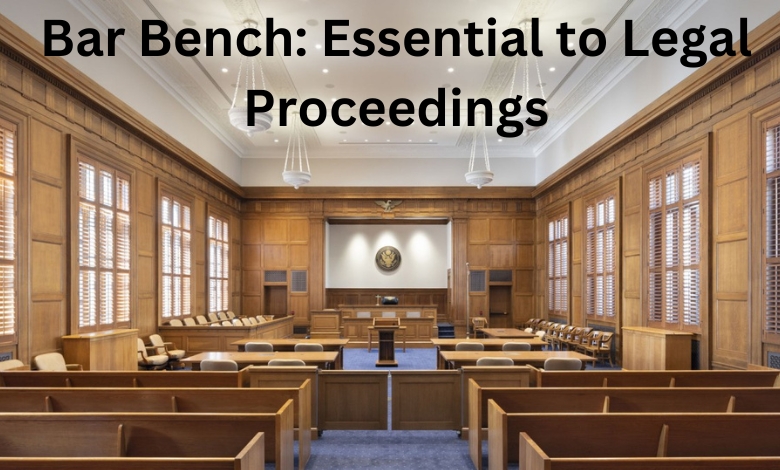Bar Bench is vital to the legal system, but its role may be unclear. Let’s explore its significance in legal proceedings. Welcome to the fascinating world of legal proceedings, where justice is served and the wheels of law turn. In this intricate dance between order and chaos, there exists a crucial element that often goes unnoticed, yet holds immense significance in shaping the course of justice – the Bar Bench.
You may have heard these terms mentioned in courtroom dramas or legal discussions, but do you truly understand their purpose? Join us as we delve into the depths of this enigmatic duo – the Bar Bench – unravelling its history, exploring its functions, and examining its importance in legal proceedings around the world.
So grab your gavel and put on your thinking cap as we embark upon an enlightening journey through time and jurisprudence. Let’s discover what lies behind those hallowed halls where justice is both sought and dispensed – The Bar Bench.
Hints of Content
What is a Bar Bench?
The Bar Bench plays a crucial role in the legal system, but what exactly is it? Let’s delve into this important aspect of legal proceedings.
The term “Bar Bench” refers to two distinct entities within a courtroom. The Bar represents the group of legal professionals, including lawyers and advocates, who are licensed to practice law. On the other hand, the Bench refers to the judge or panel of judges presiding over a case.
The Bar is responsible for presenting arguments on behalf of their clients and providing legal counsel. They are required to adhere to ethical standards while advocating for their clients’ interests. Lawyers at the Bar play an essential role in ensuring justice is served by presenting evidence, cross-examining witnesses, and making persuasive arguments before the court.
On the contrary, the Bench represents judicial authority and impartiality. Judges have several responsibilities during legal proceedings, such as interpreting laws, determining guilt or innocence in criminal cases, and resolving disputes between parties in civil matters. They ensure that trials are conducted fairly and according to established rules and procedures.
While both entities work together towards achieving justice, there are clear differences between them. The Bar operates independently from the judiciary and is subject to its own regulations set by professional bodies like bar associations or law societies. Conversely,the Bench exercises authority granted by law without interference or bias from external sources.
History and Evolution of the Bar Bench
The history and evolution of the Bar Bench is a fascinating journey that traces back centuries. It has its roots in ancient legal systems and has evolved over time to become an integral part of modern-day legal proceedings.
In the early days, legal disputes were resolved by community leaders or elders who acted as judges. These individuals would sit on a raised platform, known as the bench, while lawyers or representatives from each party stood at a designated area called the bar. This physical separation between the judge and advocates came to symbolise their distinct roles and responsibilities.
As societies became more complex, so did the need for specialised knowledge in legal matters. This led to the emergence of professional lawyers who began congregating around courts to offer their services. Gradually, this congregation gave rise to what we now know as the bar – an association of licensed attorneys who are qualified to practise law.
Over time, with advancements in legal education and establishment of formal judicial systems, the role of both the bar and bench became more defined. The bench represents judicial authority – impartiality, wisdom, and expertise in interpreting laws – while the bar represents advocacy – persuasive arguments on behalf of clients.
The concept of adversarial proceedings further solidified these distinctions between judges on one hand (the bench) and attorneys on another (the bar). In this system, both sides present their cases before a neutral judge who carefully considers evidence presented by each advocate before delivering a verdict.
Today’s Bar Bench is not only seen as separate entities but also interconnected components that ensure justice is served efficiently. Lawyers rely on precedents set by previous case judgments made by judges sitting within similar court hierarchies known as benches.
Functions and Importance of the Bar Bench in Legal Proceedings
The Bar Bench is a crucial element in the functioning of legal proceedings. Its functions and importance cannot be overstated. First and foremost, the Bar Bench serves as the platform where lawyers present their arguments, evidence, and legal expertise to support their clients’ cases. It acts as a stage for advocates to articulate their arguments persuasively.
Moreover, the Bar Bench plays a vital role in ensuring fairness and justice within the courtroom. Judges sitting on the bench carefully listen to both sides of an argument presented by lawyers at the bar before making impartial decisions based on facts, law, and precedent. They act as gatekeepers of justice, ensuring that all parties receive a fair hearing.
In addition to its adjudicatory function, the Bar Bench also provides guidance and mentorship to young lawyers starting their careers. Seasoned judges often share their knowledge and experience with junior members of the legal profession through mentoring programs or by offering valuable insights during court proceedings.
Differences between the Bar and the Bench
The Bar and the Bench are two integral components of any legal system, each with distinct roles and responsibilities. Understanding their differences is crucial to comprehending how legal proceedings unfold.
Let’s define these terms. The Bar refers to a collective term for all practising lawyers or advocates, whereas the Bench refers to judges or magistrates who preside over courtrooms.
One significant distinction lies in their functions. The Bar primarily represents clients by presenting arguments, providing legal advice, and advocating for their interests in court. They possess extensive knowledge of the law and use it strategically to support their clients’ cases.
On the other hand, members of the Bench have a judicial role. Their primary responsibility is to impartially interpret laws, apply them correctly, make decisions based on evidence presented by both parties through arguments made by lawyers from the bar rather than taking sides themselves.
Moreover, another difference lies in their attire. Members of the Bar typically dress in formal attire such as suits or robes according to local customs while appearing before courts; however they may not always wear wigs depending upon jurisdictional requirements whereas Judges on bench usually wear specific robes along with wigs that symbolise authority and independence.
Controversies surrounding the Bar Bench
Controversies surrounding the Bar Bench have been a topic of discussion in legal circles and beyond. One such controversy is the issue of judicial independence versus political influence. Critics argue that judges can be influenced by political pressure or biases, compromising their ability to make impartial decisions.
Another controversy pertains to diversity within the Bar Bench. There have been concerns about underrepresentation of certain marginalised groups, leading to questions about equal access to justice. Efforts are being made to address this issue through initiatives promoting diversity and inclusion in the legal profession.
The process of appointment and promotion of judges has also faced criticism. Some argue that it lacks transparency and accountability, potentially allowing for favouritism or nepotism in judicial appointments.
Additionally, there is ongoing debate regarding the balance between privacy rights and open justice. The use of closed courtrooms or publication bans has sparked discussions about the need for transparency while protecting sensitive information.
Global Perspectives on the Bar Bench
The concept of the Bar Bench is not limited to a particular country or legal system. It exists in various forms and plays a crucial role in legal proceedings around the world. Different countries have different approaches to the functional aspects of the Bar Bench, but its significance remains constant.
In some countries, such as England and Wales, advocates are required to join an Inn of Court before they can practise law professionally. This tradition ensures that lawyers receive proper training and adhere to ethical standards. The Bar Council regulates these Inns and maintains professional standards within the legal profession.
In contrast, other countries like India have separate bar associations for different courts, including High Courts and Supreme Court. These associations play a vital role in safeguarding lawyers’ rights and addressing their concerns regarding working conditions and professional development.
Similarly, many jurisdictions allow attorneys to appear before courts without needing to join any specific organisation or association. However, even in these cases, there are often regulations in place that outline minimum qualifications for practising law.
Global perspectives on the Bar Bench emphasise creating a balance between providing access to justice for individuals seeking representation while maintaining high standards within the legal profession. Each jurisdiction strives towards achieving this delicate equilibrium based on its unique cultural context and historical development.
Understanding how different countries approach the functioning of their Bar Benches can provide valuable insights into diverse legal systems worldwide.
Conclusion
The Bar Bench plays a vital role in legal proceedings around the world. It serves as a platform for lawyers to advocate for their clients and present their arguments before a judge. The history and evolution of the Bar Bench have shaped its functions and importance in modern-day courts.



